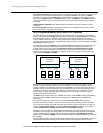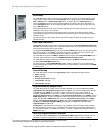
The engine of growth for your emerging businesses.
Please see the Legal Information section for important notices and information.
10
capabilities, including:
• Predictive Failure Analysis for system fans
• Graphical console redirection over LAN
• Web-based out-of-band control
• Windows “blue screen” capture
• Remote virtual floppy and CD-ROM
• High-speed remote redirection of PCI video, keyboard and mouse
• SSL (Secure Socket Layer) and LDAP (Lightweight Directory Access Protocol) support
IBM developed IBM Systems Director Active Energy Manager to put control of system power-saving
features at the fingertips of administrators. Active Energy Manager is designed to take advantage of new
features, such as monitoring power usage and balancing the performance of the system according to
available power input. It provides the ability to plan and predict power consumption based on your
hardware configuration. It also helps enable you to reduce the infrastructure required for redundancy, by
using fewer servers on smaller power feeds and potentially lowering your overall data center support
costs. It does this by inventorying all components, then adding up the total power draw and tracking the
usage. It also includes power management and capping features to help administrators manage or reduce
power usage.
Automatic Server Restart (ASR) helps reduce downtime by restarting the server automatically in the
event of a system lockup. ASR technology is a combination of hardware circuitry tied into the server’s
system reset function and a device driver. As long as the server continues running, the ASR watchdog
timer will keep being reset, but if the operating system crashes or the hardware freezes somehow the ASR
software will be unable to reset the hardware timer. If the timer is not reset within five minutes, it
automatically triggers the ASR hardware, which immediately restarts the server (and logs an ASR event
with IBM Systems Director). These features are designed so that no more than five minutes can pass
before the server is restarted.
Wake on LAN permits the server to be remotely powered on if it has been shut off. Once powered up, the
server can be controlled across the network, using the Preboot Execution Environment (PXE).
Like Wake on LAN, PXE is system firmware. It enables software such as the optional IBM Remote
Deployment Manager to take control of a system before the BIOS, operating system or applications are
loaded (using Wake on LAN/PXE) and lets an administrator perform many low-level tasks remotely that
would otherwise require a visit to each system. These tasks may include such things as formatting a hard
disk drive, updating system firmware, or deploying a Windows or Linux operating system.
Text Console Redirection support allows the administrator to remotely view x3400 M2 text messages
over serial or LAN. An optional IMM Virtual Media Key adds graphical console redirection.
Predictive Failure Analysis (PFA) is designed to allow the system to detect impending failure of
supported components (processor, memory, HDDs, fans, VRM, and power supplies) before actual failure,
and alert the administrator through IBM Systems Director. This gives you the ability to replace the failing
component before it fails, resulting in increased uptime.
IBM Systems Director software for advanced workgroup management is included with the x3400 M2.
IBM Systems Director comes with a portfolio of tools, including Systems Director Active Energy Manager,
System and Support Manager, and other tools. System Availability (a no-charge download) and Capacity
Manager (sold separately) are available as add-ons for additional server management and increased
availability. IBM Systems Director provides a single uniform graphical interface for all of these systems
management functions.
IBM Systems Director enables you to customize thresholds and monitor system components (for things
like temperature, voltage regulation, etc.) to help maximize uptime.
Key Options
IBM options for System x servers help you take your servers to a higher
level
You can rely on System x options to supply a complete solution for your business needs. Options help you
create an optimized server system to meet your data protection, storage and availability needs. Every IBM
option is designed and tested for peak performance and flexibility, helping to maximize your return on
investment. The combination of System x servers and options lets you keep your fingers on the pulse of
your e-business.
Processors — The Intel Xeon processor provides high clock rates, four cores, 64-bit extensions, a large
cache and advanced features for availability and manageability. Large cache size, combined with fast
1066MHz or 800MHz memory access and an integrated memory controller reduce memory latency and
facilitates the movement of data. (Note: System performance depends not only on the number of
processors in the server but also on the power and functionality of each processor.) Adding a second
processor may be a cost-effective way to achieve significant performance improvements.
Memory — Memory is a significant factor in systems application performance. Adding more memory to a
System x server is one of the most effective ways to increase application performance. For best


















